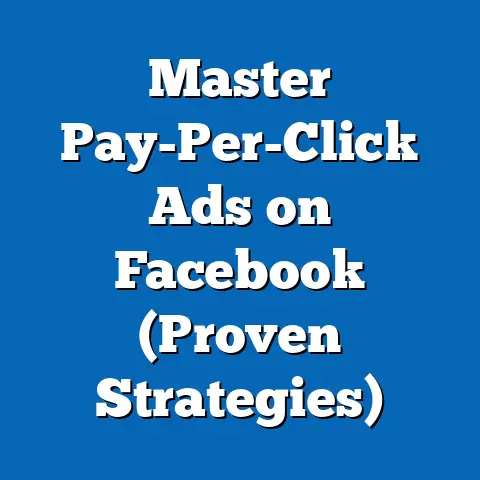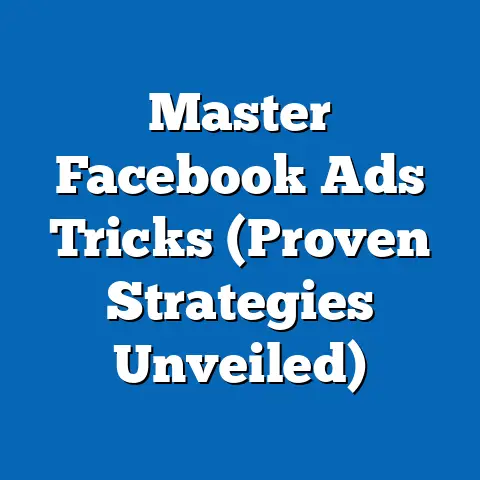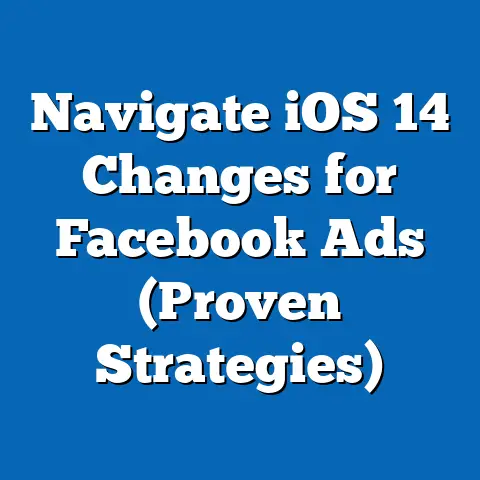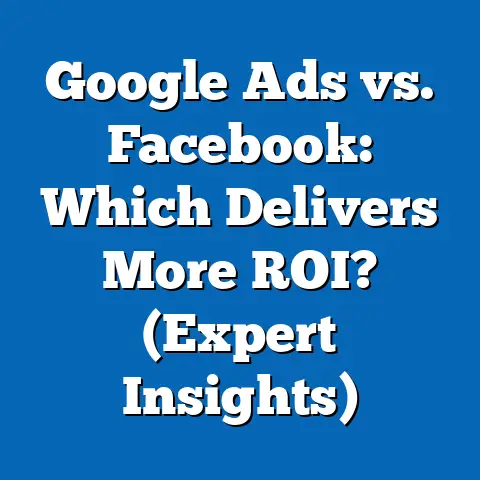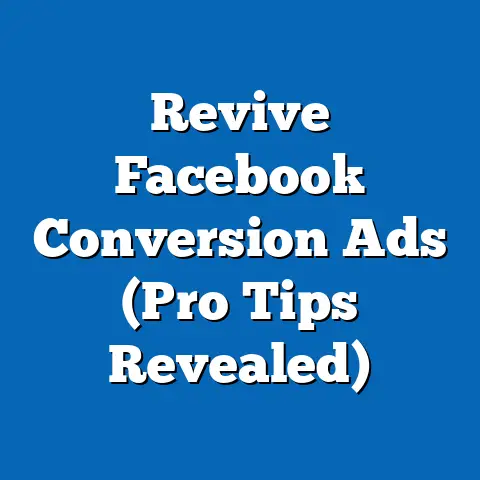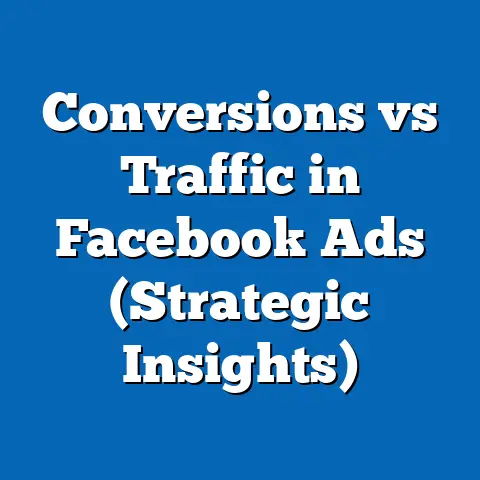Stop Google Ads on Facebook (Proven Strategies Revealed)
I’ve always been fascinated by the art of creation, whether it’s the meticulous work of a woodworker shaping a piece of timber or the delicate brushstrokes of a painter bringing a canvas to life. There’s something deeply satisfying about taking raw materials and transforming them into something beautiful and functional. And you know what? I see a similar kind of craftsmanship in digital advertising, especially when it comes to platforms like Facebook.
In the digital age, advertising has evolved into an art form in itself. It requires a keen understanding of human psychology, creative flair, and a knack for data analysis. Just as a craftsman carefully selects their tools and materials, a digital advertiser must strategically choose the right platforms, targeting options, and ad formats to reach their desired audience effectively.
Understanding the Landscape of Online Advertising
To make an informed decision about your advertising strategy, it’s crucial to understand the fundamental differences between Google Ads and Facebook Ads. These platforms operate on different principles and cater to different user behaviors.
Google Ads: Think of Google Ads as a response-driven system. Users actively search for specific keywords or phrases, indicating a clear intent to find information or purchase a product. Your ads appear in search results or on websites that are part of the Google Display Network, targeting users based on their search queries and browsing history. The advantage here is reaching people who are already looking for what you offer.
Facebook Ads: Facebook Ads, on the other hand, is more of a discovery-driven system. Users are passively scrolling through their feeds, connecting with friends and family, and consuming content. Your ads are strategically placed within their feeds, targeting them based on their demographics, interests, behaviors, and connections. The advantage here is reaching a broad audience and creating demand for your products or services.
Key Differences at a Glance:
- Targeting: Google Ads targets users based on keywords and search intent, while Facebook Ads targets users based on demographics, interests, and behaviors.
- Ad Formats: Google Ads primarily uses text-based ads, while Facebook Ads offers a wider variety of ad formats, including images, videos, carousels, and collections.
- User Intent: Google Ads caters to users with high purchase intent, while Facebook Ads caters to users in various stages of the buying cycle.
- Cost: Google Ads costs can be higher due to competition for specific keywords, while Facebook Ads costs are generally lower, but can vary depending on targeting and ad quality.
Effectiveness: Stats and Case Studies
While both platforms can be effective, recent market research suggests that Facebook Ads can sometimes offer a higher ROI. For example, a study by HubSpot found that Facebook Ads have a higher conversion rate than Google Ads in certain industries, particularly those targeting a younger demographic.
- Case Study 1: E-commerce Brand: I worked with an e-commerce brand selling handmade jewelry. They were struggling with high CPC (Cost Per Click) on Google Ads and decided to shift a portion of their budget to Facebook Ads. By leveraging Facebook’s detailed targeting options, we were able to reach a highly specific audience interested in handmade jewelry and achieved a 30% reduction in CPA.
- Case Study 2: Local Restaurant: A local restaurant was looking to increase foot traffic. They were running Google Ads targeting users searching for “restaurants near me.” While this was effective, we also implemented Facebook Ads targeting users within a specific radius of the restaurant, with interests in food and dining. The Facebook Ads campaign resulted in a significant increase in reservations and walk-in customers.
These case studies demonstrate that Facebook Ads can be a powerful tool for businesses looking to reach a specific audience, generate leads, and drive sales.
Why Consider Stopping or Reducing Google Ads Spend?
While Google Ads remains a dominant force in the digital advertising landscape, there are several reasons why businesses may need to consider stopping or reducing their Google Ads spend in favor of Facebook advertising:
- Rising Costs: Competition for keywords on Google Ads can be fierce, driving up the cost per click and making it difficult for small businesses to compete.
- Complexity: Managing Google Ads campaigns effectively requires a significant investment of time and expertise.
- Limited Targeting: Google Ads targeting options can be limited compared to Facebook Ads, making it difficult to reach a specific audience.
- Better Engagement on Facebook: Facebook offers richer engagement opportunities through comments, shares, and likes, allowing businesses to build relationships with their audience.
Takeaway: Understanding the nuances of each platform is essential. Google Ads excels at capturing existing demand, while Facebook Ads is brilliant at creating demand. Assessing your business goals and target audience will help you determine the right platform for your advertising efforts.
Why Stop Google Ads?
Before I dive into the strategies for leveraging Facebook Ads, let’s address the elephant in the room: why would you even consider stopping Google Ads? I know it’s a staple for many businesses, but the truth is, it’s not always the best fit.
Common Challenges with Google Ads:
- The Cost Factor: Google Ads operates on a pay-per-click (PPC) model. While this can be effective, it also means you’re paying every time someone clicks your ad, regardless of whether that click results in a conversion. For highly competitive keywords, the cost per click can be astronomical, quickly eating into your budget. I’ve seen businesses spend thousands of dollars on Google Ads without seeing a significant return.
- The Competition is Fierce: In many industries, the competition for keywords is intense. Large corporations with deep pockets can outbid smaller businesses, making it difficult to get your ads seen. This is especially true for generic keywords like “insurance” or “credit cards.”
- The Complexity Conundrum: Google Ads is a complex platform with a steep learning curve. Managing campaigns effectively requires a significant investment of time and expertise. You need to understand keyword research, bidding strategies, ad copywriting, and landing page optimization. It’s easy to get lost in the weeds and make costly mistakes.
- The Landing Page Labyrinth: Driving traffic to your website is only half the battle. You also need to ensure that your landing page is optimized for conversions. This means creating a compelling offer, writing persuasive copy, and designing a user-friendly experience. If your landing page isn’t up to par, you’ll be wasting your ad spend.
Limitations of Google Ads in Certain Industries:
While Google Ads can be effective for businesses selling products or services that people actively search for, it’s not always the best fit for every industry.
- Niche Markets: If you’re targeting a niche market with highly specific interests, Facebook Ads may be a better option. Facebook’s detailed targeting options allow you to reach a highly specific audience based on their demographics, interests, and behaviors.
- Visual Products: If you’re selling visual products like clothing or jewelry, Facebook Ads can be more effective than Google Ads. Facebook’s ad formats allow you to showcase your products in a visually appealing way.
- Building Brand Awareness: If your goal is to build brand awareness, Facebook Ads can be a powerful tool. Facebook allows you to reach a large audience and create engaging content that resonates with your target market.
The Psychology of Consumer Behavior: Google vs. Facebook
It’s also important to consider the psychological aspects of consumer behavior on Google versus Facebook.
- Google: Intent-Driven: Users on Google are typically in a problem-solving mode. They have a specific need or question and are actively searching for a solution. Your ads need to provide a clear and concise answer to their query.
- Facebook: Discovery-Driven: Users on Facebook are typically in a relaxed, social mode. They’re browsing their feeds, connecting with friends and family, and consuming content. Your ads need to be engaging, visually appealing, and relevant to their interests.
My Own Experience: I once worked with a client who was selling high-end coffee beans. They were spending a fortune on Google Ads targeting keywords like “best coffee beans” and “gourmet coffee.” While they were generating some sales, the cost per acquisition was very high. We decided to shift a portion of their budget to Facebook Ads, targeting users interested in coffee, gourmet food, and specialty beverages. We created visually appealing ads showcasing the unique flavor profiles of their coffee beans. The Facebook Ads campaign resulted in a significant increase in sales and a much lower cost per acquisition.
Takeaway: Don’t blindly follow the crowd. Evaluate whether Google Ads is truly the best fit for your business. Consider the costs, competition, complexity, and limitations of the platform. Think about your target audience, your product, and your goals. Facebook Ads may offer a more effective and cost-efficient alternative.
Proven Strategies for Leveraging Facebook Ads
Now, let’s get to the heart of the matter: how to make Facebook Ads work for you. Here are some proven strategies that I’ve used to achieve success with Facebook advertising.
1. Audience Targeting: The Key to Relevance
Facebook’s targeting options are incredibly powerful. They allow you to reach a highly specific audience based on a wide range of factors. But with great power comes great responsibility. You need to use these targeting options wisely to ensure that your ads are relevant to the people who see them.
- Core Audiences: This is the foundation of your targeting strategy. You can target users based on their demographics (age, gender, location), interests (hobbies, activities, pages they like), and behaviors (purchase history, device usage).
- Custom Audiences: This allows you to target users based on your own data. You can upload a list of email addresses, phone numbers, or website visitors. This is a great way to re-engage existing customers or target users who have shown interest in your products or services.
- Lookalike Audiences: This is where the magic happens. Facebook can create a “lookalike” audience based on your existing customers. This means that Facebook will find users who share similar characteristics and behaviors as your best customers. This is a powerful way to expand your reach and find new customers who are likely to be interested in your products or services.
Example: Let’s say you’re selling organic baby food. You could create a custom audience based on your existing customers who have purchased baby food in the past. Then, you could create a lookalike audience based on that custom audience. Facebook will find users who are likely to be parents with young children and who are interested in organic food.
2. Compelling Creative: Capturing Attention
In the fast-paced world of social media, you have only a few seconds to grab someone’s attention. Your ad creative needs to be visually appealing, engaging, and relevant to your target audience.
- High-Quality Images and Videos: Use professional-quality images and videos that showcase your products or services in the best possible light.
- Compelling Copywriting: Write clear, concise, and persuasive copy that highlights the benefits of your products or services. Use strong calls to action that encourage users to take the next step.
- Relevance is Key: Your ad creative needs to be relevant to your target audience. Use images, videos, and copy that resonate with their interests and needs.
Example: Let’s say you’re selling travel packages to Bali. You could use stunning photos and videos of Bali’s beaches, temples, and rice paddies. Your copy could highlight the unique experiences that travelers can have in Bali, such as surfing, yoga, and exploring the local culture.
3. Ad Formats: Choosing the Right Canvas
Facebook offers a variety of ad formats to choose from, each with its own strengths and weaknesses.
- Image Ads: Simple and effective for showcasing your products or services.
- Video Ads: Engaging and immersive for telling your brand story.
- Carousel Ads: Allows you to showcase multiple products or services in a single ad.
- Collection Ads: Perfect for e-commerce businesses, allowing users to browse and purchase products directly from the ad.
- Lead Ads: Collect leads directly from Facebook without sending users to your website.
Example: Let’s say you’re selling a new line of clothing. You could use a carousel ad to showcase multiple items from the collection. Each item could have its own image, description, and call to action.
4. A/B Testing: The Scientific Method for Ads
A/B testing, also known as split testing, is a crucial part of optimizing your Facebook ad campaigns. It involves testing different versions of your ads to see which performs best.
- Test One Variable at a Time: When A/B testing, it’s important to test only one variable at a time. This allows you to isolate the impact of that variable on your ad performance.
- Test Different Headlines, Images, and Calls to Action: Experiment with different headlines, images, and calls to action to see which resonates best with your target audience.
- Use Facebook’s A/B Testing Tool: Facebook offers a built-in A/B testing tool that makes it easy to test different versions of your ads.
Example: Let’s say you’re running an ad for a new online course. You could test two different headlines: “Learn the Secrets of Facebook Advertising” vs. “Become a Facebook Ads Expert.” You could then track which headline generates more clicks and conversions.
My Personal Tip: Don’t be afraid to experiment! The key to success with Facebook Ads is to constantly test and optimize your campaigns. I’ve had campaigns that I thought were sure to be winners completely bomb, and vice versa. The only way to know what works is to test it.
Takeaway: Facebook Ads success hinges on relevance, engagement, and continuous optimization. By mastering audience targeting, crafting compelling creative, choosing the right ad formats, and A/B testing your campaigns, you can unlock the full potential of Facebook advertising.
Measuring Success and ROI on Facebook Ads
Running a Facebook ad campaign without tracking its performance is like sailing a ship without a compass. You need to know where you’re going and whether you’re on the right track. That’s why measuring success and ROI (Return on Investment) is crucial.
Metrics That Matter:
- Click-Through Rate (CTR): This is the percentage of people who see your ad and click on it. A high CTR indicates that your ad is relevant and engaging to your target audience.
- Cost Per Click (CPC): This is the amount you pay each time someone clicks on your ad. A low CPC indicates that your ad is efficient and cost-effective.
- Conversion Rate: This is the percentage of people who click on your ad and take a desired action, such as making a purchase, filling out a form, or downloading a resource. A high conversion rate indicates that your landing page is optimized for conversions.
- Cost Per Acquisition (CPA): This is the amount you pay for each conversion. A low CPA indicates that your ad campaign is generating leads or sales at a cost-effective rate.
- Return on Ad Spend (ROAS): This is the amount of revenue you generate for every dollar you spend on advertising. A high ROAS indicates that your ad campaign is generating a significant return on investment.
Setting Up Facebook Pixel for Tracking Conversions:
The Facebook Pixel is a snippet of code that you place on your website to track conversions and measure the effectiveness of your ads. It allows you to see what actions people are taking on your website after clicking on your ad, such as making a purchase, filling out a form, or downloading a resource.
- Create a Facebook Pixel: In your Facebook Ads Manager, navigate to the “Pixels” section and create a new pixel.
- Install the Pixel on Your Website: Follow the instructions provided by Facebook to install the pixel on your website.
- Set Up Conversion Tracking: Define the events you want to track, such as purchases, leads, or page views.
Analyzing Campaign Performance Data:
Facebook Ads Manager provides a wealth of data about your campaign performance. You can use this data to identify what’s working and what’s not, and make informed decisions about how to optimize your campaigns.
- Track Key Metrics Over Time: Monitor your CTR, CPC, conversion rate, CPA, and ROAS over time to see how your campaigns are performing.
- Segment Your Data: Segment your data by demographics, interests, and behaviors to see which audiences are responding best to your ads.
- Identify Trends and Patterns: Look for trends and patterns in your data to identify opportunities for improvement.
Real-World Example: I was working with a client who was running a Facebook ad campaign to generate leads for their business. We set up the Facebook Pixel and tracked the number of leads generated by the campaign. We noticed that the CPA was higher than we expected. We analyzed the data and discovered that the conversion rate on the landing page was low. We optimized the landing page by improving the copy, adding a video, and making the call to action more prominent. As a result, we were able to increase the conversion rate and reduce the CPA significantly.
My Pro Tip: Don’t just set it and forget it. Regularly monitor your campaign performance and make adjustments as needed. The Facebook Ads landscape is constantly evolving, so you need to stay on top of the latest trends and best practices.
Takeaway: Measuring success and ROI is essential for optimizing your Facebook ad campaigns. By tracking key metrics, setting up the Facebook Pixel, and analyzing campaign performance data, you can make informed decisions about how to improve your campaigns and achieve your business goals.
Real-Life Case Studies
To illustrate the power of Facebook Ads and the potential benefits of transitioning from Google Ads, let’s explore a few real-life case studies.
Case Study 1: The Boutique Clothing Store
- The Challenge: A small boutique clothing store was struggling to compete with larger retailers on Google Ads. The cost per click for relevant keywords was high, and they were not generating enough sales to justify their ad spend.
- The Solution: We shifted their focus to Facebook Ads, targeting women aged 25-45 with interests in fashion, style, and shopping. We created visually appealing ads showcasing their unique clothing items and highlighting their commitment to quality and customer service.
- The Results: The Facebook Ads campaign generated a significant increase in website traffic and sales. The cost per acquisition was much lower than on Google Ads, and they were able to reach a highly targeted audience.
Key Takeaways:
- Facebook Ads can be a more cost-effective option for small businesses that are struggling to compete on Google Ads.
- Visual ads are particularly effective for businesses selling clothing and other visual products.
- Detailed targeting options allow you to reach a highly specific audience.
Case Study 2: The Local Dentist
- The Challenge: A local dentist was looking to attract new patients. They were running Google Ads targeting keywords like “dentist near me” and “teeth whitening.” While this was generating some leads, the cost per lead was high.
- The Solution: We implemented a Facebook Ads campaign targeting people in the local area with interests in dental health and wellness. We created ads highlighting their expertise, their state-of-the-art equipment, and their commitment to patient care.
- The Results: The Facebook Ads campaign generated a significant increase in new patient inquiries. The cost per lead was much lower than on Google Ads, and they were able to build relationships with potential patients through Facebook.
Key Takeaways:
- Facebook Ads can be a powerful tool for local businesses looking to attract new customers.
- Ads that highlight your expertise and commitment to customer care can be highly effective.
- Facebook allows you to build relationships with potential customers through comments, shares, and likes.
Case Study 3: The Online Course Provider
- The Challenge: An online course provider was struggling to generate sales for their courses. They were running Google Ads targeting keywords like “online course” and “learn new skills.” While this was generating some traffic, the conversion rate was low.
- The Solution: We implemented a Facebook Ads campaign targeting people with interests in specific skills and industries. We created ads showcasing the benefits of their courses and highlighting the success stories of their students.
- The Results: The Facebook Ads campaign generated a significant increase in course sales. The conversion rate was much higher than on Google Ads, and they were able to reach a highly targeted audience.
Key Takeaways:
- Facebook Ads can be a powerful tool for businesses selling online courses and other educational products.
- Ads that highlight the benefits of your products and the success stories of your customers can be highly effective.
- Detailed targeting options allow you to reach a highly specific audience interested in specific skills and industries.
General Lessons Learned:
- Know Your Audience: The most important lesson from these case studies is that you need to know your audience. Understand their demographics, interests, and behaviors. Use Facebook’s targeting options to reach them with relevant ads.
- Create Compelling Ads: Your ads need to be visually appealing, engaging, and relevant to your target audience. Use high-quality images and videos, write persuasive copy, and include strong calls to action.
- Track Your Results: Track your results closely and make adjustments as needed. Monitor your CTR, CPC, conversion rate, CPA, and ROAS. Use this data to identify what’s working and what’s not, and make informed decisions about how to optimize your campaigns.
Takeaway: These case studies demonstrate that Facebook Ads can be a powerful alternative to Google Ads for businesses of all sizes and in various industries. By understanding your audience, creating compelling ads, and tracking your results, you can achieve success with Facebook advertising.
Conclusion
In conclusion, the decision to “stop Google Ads on Facebook” isn’t about abandoning one platform entirely for another. It’s about making a strategic shift, re-evaluating your advertising approach, and embracing the unique strengths that Facebook advertising offers.
I’ve shared with you the key differences between Google Ads and Facebook Ads, the challenges businesses often face with Google Ads, and the proven strategies for leveraging Facebook Ads to achieve your business goals. I’ve also presented real-life case studies that demonstrate the power of Facebook Ads and the potential benefits of transitioning from Google Ads.
Key Takeaways to Remember:
- Facebook Ads is a Powerful Alternative: Facebook Ads can be a more cost-effective and efficient option for businesses looking to reach a specific audience, generate leads, and drive sales.
- Targeting is Key: Facebook’s detailed targeting options allow you to reach a highly specific audience based on their demographics, interests, and behaviors.
- Compelling Creative Matters: Your ad creative needs to be visually appealing, engaging, and relevant to your target audience.
- A/B Testing is Essential: A/B testing is crucial for optimizing your Facebook ad campaigns and improving your ROI.
- Measure Your Results: Track your results closely and make adjustments as needed.
I encourage you to embrace the craftsmanship of Facebook advertising. Experiment with different targeting options, ad formats, and creative approaches to find what works best for your unique business and audience. Don’t be afraid to try new things and learn from your mistakes.
Your Next Steps:
- Assess Your Current Advertising Strategy: Evaluate your current Google Ads campaigns and identify any challenges you’re facing.
- Define Your Goals: Clearly define your goals for your Facebook Ads campaigns. What do you want to achieve?
- Research Your Audience: Thoroughly research your target audience and understand their demographics, interests, and behaviors.
- Create Compelling Ads: Develop visually appealing and engaging ads that resonate with your target audience.
- Track Your Results: Set up the Facebook Pixel and track your results closely.
- Optimize Your Campaigns: Continuously optimize your campaigns based on your results.
So, are you ready to take the first step and explore the potential of Facebook Ads? I believe you can achieve significant success by strategically leveraging this platform. It’s time to unleash your inner advertising craftsman and create campaigns that not only reach your target audience but also resonate with them on a deeper level. Good luck!

